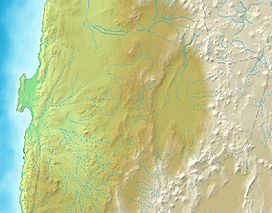Cerro Tujle (also known as Cerro Tucle or Cerro Tugle) is a mafic volcanic centre in the Central Volcanic Zone of the Andes,[2] Chile. It forms a 60 metres (200 ft) deep maar[1] that may have formed half a million years ago.[3] Its eruption products are aphyric.[2] Previously in 1977, this crater has been identified as a meteor crater with diameters of 300 by 350 metres (980 ft × 1,150 ft).[4]
| Cerro Tujle | |
|---|---|
| Cerro Tucle, Cerro Tugle | |
| Highest point | |
| Elevation | 3,550 m (11,650 ft)[1] |
| Coordinates | 23°49′S 67°57′W / 23.82°S 67.95°W[1] |
| Geography | |
| Country | |
| Region | Antofagasta |
| Parent range | Altiplano, Andes |
| Geology | |
| Orogeny | Andean |
| Rock age | Holocene |
| Mountain type | Maar |
| Volcanic belt | Central Volcanic Zone |
The crater lies between the Salar de Atacama and the Western Cordillera at an elevation of 3,554 metres (11,660 ft) on the Cordón de Tujle ridge, 20 kilometres (12 mi) south-east of Peine. The crater is 333 metres (1,093 ft) wide, elliptical and surrounded by volcanic deposits. The crater appears to have formed, after an initial lava flow eruption turned phreatomagmatic. It is embedded in the Tucúcaro Ignimbrite, which overlies an Ordovician basement and Paleozoic-Mesozoic volcanic and Neozoic mixed sediments. There are other volcanic systems in the vicinity,[5] forming an extended area of monogenetic volcanoes.[3]
See also
editReferences
edit- ^ a b c "Cerro Tujle". Global Volcanism Program. Smithsonian Institution.
- ^ a b van Alderwerelt, Brennan; Peate, Ingrid Ukstins; Burns, Dale; Ramos, Frank. "In situ geochemistry and isotopic composition of young, small-volume mafic eruptive centers in the Chilean Altiplano". researchgate.net. Retrieved 14 January 2016.
- ^ a b Loaiza, Camila; Larrea, Patricia; Salinas, Sergio; Parra-Encalada, Daniela; Cartagena, Rubén; Godoy, Benigno (2 December 2023). "The temporal evolution of monogenetic volcanism in the Central Andes: 40Ar/39Ar geochronology of El Negrillar volcanic field, Chile". Bulletin of Volcanology. 86 (1). doi:10.1007/s00445-023-01691-8. S2CID 265517708.
- ^ Ferrando A., F. (1977). "Two Unknown Meteor Craters in Antofagasta Region, Northern Chile". Revista Geográfica (85): 210–212. JSTOR 40993113.
- ^ Ureta, Gabriel; Aguilera, Felipe; Németh, Károly; Inostroza, Manuel; González, Cristóbal; Zimmer, Martin; Menzies, Andrew (1 December 2020). "Transition from small-volume ephemeral lava emission to explosive hydrovolcanism: The case of Cerro Tujle maar, northern Chile". Journal of South American Earth Sciences. 104: 102885. Bibcode:2020JSAES.10402885U. doi:10.1016/j.jsames.2020.102885. ISSN 0895-9811. S2CID 224950244.
